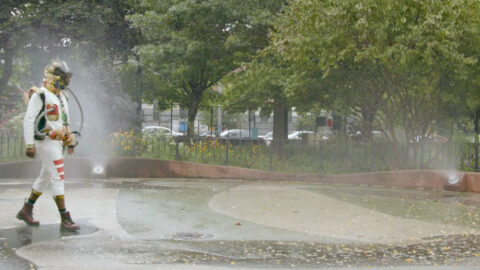Interview: Brett Story
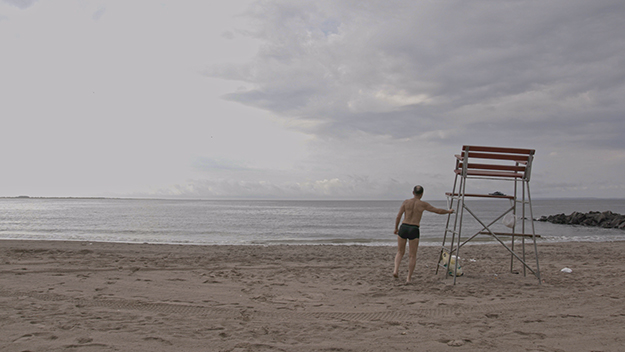
A world premiere at the True/False Film Fest, The Hottest August holds up New York circa August 2017 for a kaleidoscopic look by the light of a burning world. Director Brett Story (The Prison in Twelve Landscapes) beads together conversations and curiosities across the five boroughs, people and places shadowed by economic anxieties and buoyed by coping methods. A poised voiceover, à la Chris Marker’s Le Joli Mai, introduces the endeavor with a clinical air—and then two union guys say hi and answer questions from the second-story window of a house. Systems of thought and ways of life vie for attention throughout the film, as we move from sidewalk lounge-chair chats to explain-it-all spiels in offices to geometric slices of the skyline to a nature conservationist musing in a boat about the human animal. The conversations are casual but even with the slightest scratching of surfaces, the sense of crisis is legible.
Story, who holds a PhD in geography, worked for The Nation in New York as well as doing a postdoc there, and now teaches at Ryerson University in Toronto. I spoke with the filmmaker just before one of her movie’s public screenings at the Columbia, Missouri festival. The Hottest August also screens at South by Southwest and CPH:DOX.
For me the key shot is the people gingerly getting off the broken roller coaster. It’s the picture of figuring out how to extricate yourself from a crisis—a broken system. Was that an important image for you as well?
Yeah. We encountered that pretty spontaneously. We were actually in Coney Island to shoot a shark tank—it could have been a different metaphor… My cinematographer Derek [Howard] noticed out of the corner of his eye that something weird was going on with the Cyclone. And sure enough, it was broken. The staff were walking very slowly up and then leading people down. It’s symbolic of a society in distress, infrastructure crumbling. This is New York City, where already all the climate stories are paired with the stories about the subway system breaking down. The film is very much inviting people to think about climate change through the lens of the social order: how society is doing, the dismantling and decline of public infrastructure. It was a very powerful metaphor in those terms, and a powerful metaphor of crisis in general.
But snuck in there is this image of people holding hands and very gently leading themselves down to safety. So I don’t think you leave the film thinking, oh, that was an optimistic film or a pessimistic film. I hope it contains the possibility of thinking about how people can and do feel solidarity with each other, and have to form necessary relationships, like those people being lead very carefully down a broken roller coaster.
Beyond climate change, I think this is a film about the different systems of thought we’re applying to the world, and how each one of us puts blinkers on in some way. Some people don’t even realize they’re applying systems and they are; some people think they have it all figured out, but they’re just obscuring other matters. How do you feel about labeling this a climate change movie?
Part of the work of a title or a logline is as descriptors of your project that will compel people to watch it or not. But I also think about the terms that they set, that the film can then upset. I like playing with the expectation that this is a film about climate change, so that people have to ask themselves both, “What is it actually about?” and “What constitutes climate?” On the one hand, you’re right, it’s not actually about climate change, it’s about how society is organized and how people make sense of that. On the other hand, the way society is organized is at the root of why the planet is being destroyed right now.
How structured was the gathering of footage for the film?
It was very hard to think of structure for the film before we started, and I think it was more useful, for me, to think about method—a way of investigating. I think that formalism is most interesting when it’s in the service of a set of questions that are being asked or a subject that’s being explored. The questions that I wanted to ask are big, amorphous, unwieldy ones that are predicated on taking a lot of detours. To even start a boundless project I felt like I needed to draw boundaries. Those boundaries were that it was going to be one city over one month.
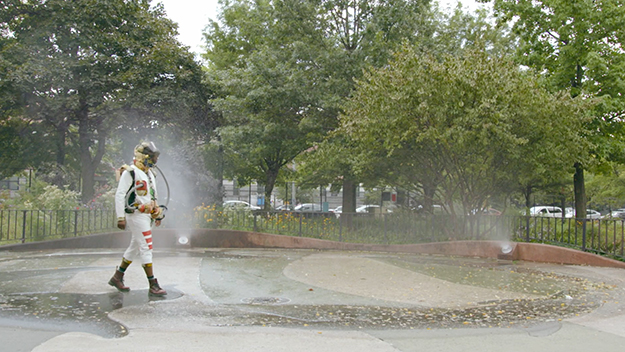
Why New York?
Partly because that’s where I was living, so it was a way of saying, “Hey, this is where I’m at right now and I’m going to look around, and ask my neighbors, and explore the place where I’m at.” But I think New York is both exceptional and not exceptional. It’s this dense city, it’s a seat of global power, it holds so many contradictions. It’s where the richest people in the world live and some of the poorest people in the world. There are so many cities that coexist in the same place, all these different lives and ways of being and ways of thinking are jammed up right next to each other. And then it’s surrounded by water.
Right, the front lines.
It’s able to shelter itself from the immediate effects, but also not. It felt like a good place to check in with people about how they’re living with the multiple crises of this moment. So the method is these semi-spontaneous encounters with people and then footage of ordinary events and happenings over one month. I really like the idea of being handed a hard drive full of footage from a time and saying, “What do you make of this? What film emerges out of this?” What would it would mean to make an archive film in which I was gathering the material for the archive now, and making something with it immediately?
There are some questions that I ask people repeatedly, but I also just follow conversations where they might lead, open-ended. And we try to film diverse events, with some thoughtfulness—we filmed in a lawn party because it’s 1920s-themed, and meanwhile we’re hearing news about inequality not being the same as it was in the 1920s, and Nazis marching. The method gives us this bounty of material, and then in the edit room we figure out the structure for the material.
What does filming look like on a day-to-day basis?
I realized that it couldn’t be all spontaneous. It was too difficult to say, “We’re just going to, like, go outside and see what happens.” Each day we planned one or two things, sometimes those things would be events: I’d read about a wrecking club where people pay to de-stress by beating up office supplies for 70 dollars an hour. Or we would just pick a location—let’s pick a beach and see what happens. Or a combo of the two: here’s a beach where there’s a sand castle-building contest and we don’t know who we’re going to meet, we don’t know what they’re going to say, but we know that there’s something to look at and they’ll be sitting somewhere for long periods of time. And then also we’re responding to real things that are happening: a Black Lives Matter march or anti-Trump march. Or we happened to be filming in Queens when someone read on their phone that the Charlottesville protest had broken out, and so we quickly scouted out a place with televisions on so that we could film that.
The point was to replicate what it means to just be in the world, and so when you’re moving about your day you’re taking in information all the time, and it tells you something about the bigger world, and the smaller world. And in a few cases we were also deliberately planning some people to talk to. One of the things I did was that I sent out an email to maybe a hundred people that I knew, and I said, “I’m looking to interview people, I don’t want to tell you what I want to interview them about, or what kind of people I want to interview, I just want each of you to think of one person that you know that would make for an interesting conversation and just send me their name.” And that’s how we met Al and Janet, the car mechanic and his zumba instructor wife—he repairs my friends’ cars.
With the roller coaster, I’m imagining instead that you sat in front of it for hours waiting for it to break down.
Yeah, sent our intern to unscrew a little bolt…
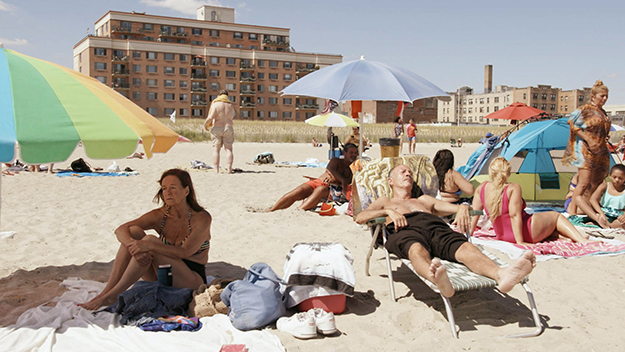
When I heard the film’s voiceover, I thought of Le Joli Mai. How much did you think about influences and diverging from techniques in films like that, or Chronicle of a Summer, or even In Jackson Heights?
Yeah, there’s a tyranny of knowing that you’re inspired by a project that’s unreplicable. Chris Marker is a brilliant filmmaker and it’s one thing to be inspired by Le Joli Mai and it’s another to assume that you can make anything achieving the greatness of that film.
He also had a talent for cultivating enigma.
Sure, but he has a particular rapport with his cameraperson, and that cameraperson has a roving eye, there’s a sense of humor to his work that is his. Part of what’s inspiring for me about Chronicle of the Summer and Le Joli Mai is that they see ordinary people, strangers in the city, as sources of interesting insight, and I feel that way as well. You can have very brief and strange encounters with people and glean something insightful. And I love a film where there’s room for subtext. I think of Le Joli Mai in particular as a film that is made up of these detours—it’s sort of about everything, but it never risks being about nothing. Gradually you realize that it’s about Parisians dealing with the collective anxiety of being a colonizing nation, and seeing an end to a brutal eight-year war with the colonies in Algeria. You don’t start that film thinking, “Oh, this is a film about Algeria.” You realize that an hour in, and it’s amazing and also really satisfying. So I was thinking similarly about the theme of climate change. It’s not an interesting theme, for me anyways—I don’t watch climate change films thinking they’re very interesting, and that doesn’t mean that they’re not worth making. I wanted to think about what would be a different, oblique way to sneak a climate change film into something else.
Another low-key movie came to mind that says more about its subjects and time than it seems. Did you ever see Wildwood, NJ?
Yes! I saw it last year for the first time. I totally loved it. The premise is conversations with girls and women of the beaches of this town in New Jersey—but it’s not about one thing, and you get so much out of it. And it’s so much fun.
I was just having a conversation about Chronicle of a Summer, about how unusual it was to see a survivor of the Holocaust who’s in her thirties, as opposed to looking back from a greater distance. It drives home how every person is a vessel of history, and in The Hottest August you’re aware of everyone’s history as well.
Yeah, and I think that the other ambition for the film was to think through the present, the past, and the future all at once. So we have this narrator that may or may not be from some point in the future, and we’re invited to take a step back and feel what it would be like to look upon us all now as if from the future. And the Afronaut character also embodies that idea.
And we all do this but it always becomes folly when people are trying to totalize the world in front of them. You have an interesting example with the finance guy who has the big theories about art and life.
He just collects art. He’s actually a hedge fund manager.
He has a lot of ideas except when you propose that capitalism may itself be a risky system, and all of a sudden he’s like, “Whoa…” There’s this inability, in a way, to actually turn around and look at oneself.
Totally. That’s my preoccupation in all my projects: what are the fantasies that we can’t let go of? And what do we buy into, not just individually but collectively? My last film was about the U.S. prison system, and for me it’s an effort to just try and invite people to think about the possibility that prisons are not doing what we think they’re doing, that we’re attached to some fantasies about them—that they keep us safe, that they’re about crime. I wanted to try to dislodge that a little bit, again, without judging people. We all do it, we all have a way to map the world, and we’re clinging to those maps of the world because they keep us safe and reassure us. But I think for anything to change, they have to be rattled a little bit.
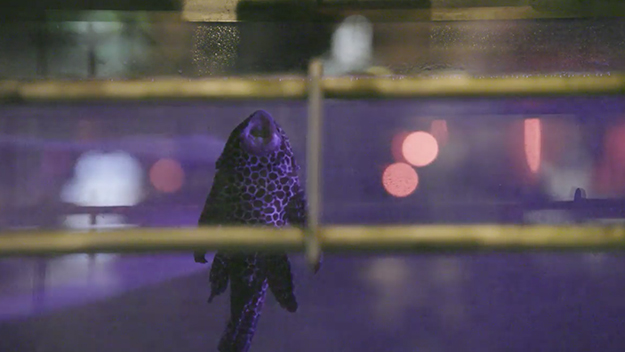
How did you feel about that with The Hottest August in terms of approaching diversity and race? How did that affect your choices?
It’s a struggle because it felt really important to not just have diversity in a kind of clinical sense, but really to showcase different ways and experiences and lives, some of those differences mediated by race and class. I think people are most interesting when they’re allowed to be as complex as they really are. And when they only have two minutes on screen, it can be hard to do that, but I also think that that’s the work you know? So part of it was just to think throughout situations, and thinking of space: New York is a really segregated city, so if you pick different neighborhoods, you get different classes, you get different races. The hardest thing actually, when you’re making a film that takes place almost entirely in a public space over the course of August, is to find really rich people. Because they are the people that can most sequester themselves on little islands, and backyards, and cottages, and they’re gone. They’re not on Coney Island and they’re not in a public park.
That’s a structured absence in a lot of documentary now, that the one percent who are often discussed, are invisible.
Yeah, and they get to be unprobed. I think often about Roger & Me. I think it is actually a masterpiece. There’s a scene in which some patron society has rented out this local jail and they’re fundraising by throwing a party there and dressing up in black-and-white and spending the night. It’s a funny scene, but I also see it as his way of finding rich people where they’re at. And that absence in my film is telling. We tried as much as possible to have a few moments where you could see power. It’s really hard to shoot in Manhattan because people don’t stop, people are on power walks to work, so there’s just a different way people occupy space. So I said, “Let’s pick this one corporate headquarters where there’s a plaza,” and then I told my DP, “This place is full of men in suits standing alone. That’s just great.” A little montage of men in suits standing alone.
At one point you have a powerful cut from that totally Depression-free 1920s lawn party to a line of people waiting outside the Housing Authority. You film a woman outside talking about where she’s at, and it sounds like she is still talking in the discourse of accountability—saying what she felt she had to say.
I’m really glad that you caught onto that. That was absolutely the point. The visuals are enough: you see it as a space that is almost entirely women of color who are in the housing court. But that interview is a glimmer of exactly what you said: a way in which people think they have to perform, or are trained to perform, accountability. We’re trained to believe that the future will get better if we individually do better. I am really interested in and preoccupied by a society that is very individualized, in which we’re told that society itself isn’t really a thing, that it’s just made by individuals doing good by themselves. If things feel bad, then it’s hard not to interpret the badness through the lens of personal failure.
I interpreted a lot of the optimism that I heard from people when I was making this film as ways to keep the burden of personal failure at bay. And I can relate to that. No wants to admit, “My life is shit.” And if your life is shit in this country, you’re told it’s your fault. It can’t be the government’s fault, it can’t be capitalism’s fault. It was amazing to me how we would hear that over and over again: people describing really difficult situations and also being like, “But it’s going to be better, tomorrow I’ve got new plans, I’m going to do this, it’s on me.” And I think for people of color, and women of color, especially, there’s that demand that we be held accountable.
Being held accountable and also asked to pretend that there’s nothing systemic involved.
What would be worse than needing something, you know? We hear those cops in Staten Island going off on people with welfare. I personally grew up on welfare, my mother was a single mother and we lived on welfare for a few years, and there’s actually nothing wrong with needing things, and needing other people. Yet we’ve so internalized this idea that the horror is to need anyone and to need your government and to need a social safety net. And people will not admit that.
Having grown up in Canada, how have you felt about the country being held up as a kind of model society?
I hate to disappoint you, but it actually feels very similar. There are exceptions and holdouts, but those holdouts feel really precious. Health care is one of those holdouts. To live in a country where healthcare is free is like a “no duh” situation—that’s the way things should be, and it really makes everyone’s lives better. But it feels like one of the few things in which Canada is different from America at this point, because the same kind of phenomena are on display. We just elected a super-right-wing premier of our province. We had a white nationalist almost win our mayoral election in Toronto. It’s a bit devastating.
Nicolas Rapold is the editor-in-chief of Film Comment and hosts The Film Comment Podcast.



